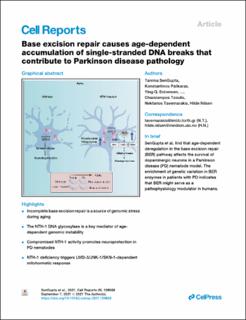| dc.contributor.author | SenGupta, Tanima | |
| dc.contributor.author | Palikaras, Konstantinos | |
| dc.contributor.author | Esbensen, Ying Q. | |
| dc.contributor.author | Konstantinidis, Georgios | |
| dc.contributor.author | Galindo, Francisco Jose Naranjo | |
| dc.contributor.author | Achanta, Kavya | |
| dc.contributor.author | Kassahun, Henok | |
| dc.contributor.author | Stavgiannoudaki, Ioanna | |
| dc.contributor.author | Bohr, Vilhelm A. | |
| dc.contributor.author | Akbari, Mansour | |
| dc.contributor.author | Gaare, Johannes | |
| dc.contributor.author | Tzoulis, Charalampos | |
| dc.contributor.author | Tavernarakis, Nektarios | |
| dc.contributor.author | Nilsen, Hilde | |
| dc.date.accessioned | 2021-11-26T13:12:42Z | |
| dc.date.available | 2021-11-26T13:12:42Z | |
| dc.date.created | 2021-10-18T10:16:31Z | |
| dc.date.issued | 2021 | |
| dc.identifier.issn | 2211-1247 | |
| dc.identifier.uri | https://hdl.handle.net/11250/2831693 | |
| dc.description.abstract | Aging, genomic stress, and mitochondrial dysfunction are risk factors for neurodegenerative pathologies, such as Parkinson disease (PD). Although genomic instability is associated with aging and mitochondrial impairment, the underlying mechanisms are poorly understood. Here, we show that base excision repair generates genomic stress, promoting age-related neurodegeneration in a Caenorhabditis elegans PD model. A physiological level of NTH-1 DNA glycosylase mediates mitochondrial and nuclear genomic instability, which promote degeneration of dopaminergic neurons in older nematodes. Conversely, NTH-1 deficiency protects against α-synuclein-induced neurotoxicity, maintaining neuronal function with age. This apparent paradox is caused by modulation of mitochondrial transcription in NTH-1-deficient cells, and this modulation activates LMD-3, JNK-1, and SKN-1 and induces mitohormesis. The dependance of neuroprotection on mitochondrial transcription highlights the integration of BER and transcription regulation during physiological aging. Finally, whole-exome sequencing of genomic DNA from patients with idiopathic PD suggests that base excision repair might modulate susceptibility to PD in humans. | en_US |
| dc.language.iso | eng | en_US |
| dc.publisher | Elsevier | en_US |
| dc.rights | Navngivelse 4.0 Internasjonal | * |
| dc.rights.uri | http://creativecommons.org/licenses/by/4.0/deed.no | * |
| dc.title | Base excision repair causes age-dependent accumulation of single-stranded DNA breaks that contribute to Parkinson disease pathology | en_US |
| dc.type | Journal article | en_US |
| dc.type | Peer reviewed | en_US |
| dc.description.version | publishedVersion | en_US |
| dc.rights.holder | Copyright 2021 the authors | en_US |
| dc.source.articlenumber | 109668 | en_US |
| cristin.ispublished | true | |
| cristin.fulltext | original | |
| cristin.qualitycode | 2 | |
| dc.identifier.doi | 10.1016/j.celrep.2021.109668 | |
| dc.identifier.cristin | 1946597 | |
| dc.source.journal | Cell reports | en_US |
| dc.identifier.citation | Cell reports. 2021, 36 (10), 109668. | en_US |
| dc.source.volume | 36 | en_US |
| dc.source.issue | 10 | en_US |

